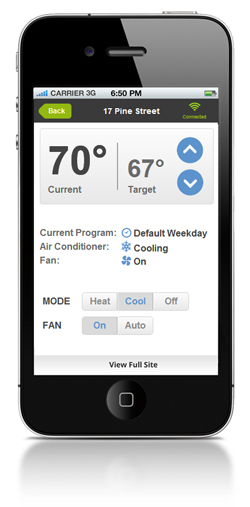Big Data + Smart Thermostats Shaves Peak Load
A deal between startup EcoFactor and a Nevada utility shows the potential of coupling data analytics with smart thermostats to make the grid more efficient and reliable.

NV Energy plans to install 10,000 smart thermostats at homes in Las Vegas area for its demand response program to cut the power load on the grid during peak times. As with other demand-response programs, consumers receive a discount for agreeing to let the utility raise air conditioner temperature settings during very hot days.
What sets this apart from most other utility demand-response programs is EcoFactor’s cloud-based data analytics software. In addition to controlling thermostats during peak events, which occur only during the hottest days of the year, the software will make minor adjustments to thermostats all year round. By analyzing consumer actions and individual building performance, EcoFactor says it can lower heating and cooling load by 13 percent on average.
The company’s software continually gathers data from the thermostat, such building temperature, local weather and when consumers adjust settings. Based on an analysis of the data, it sends out instructions to the thermostat to improve efficiency. The thermostat communicates with the home WiFi network and EcoFactor connects to the thermostat over a home broadband connection.
The changes are typically very minor adjustments so people’s comfort isn’t affected. But over the course of the month, several one degree set point changes add up to significant energy savings, says John Steinberg, EcoFactor’s executive vice president of business development. The system also does things such precooling a building before a demand response event to avoid discomfort, he added.
NV Energy, which did two pilots before this program, expects it can shave 25 megawatts of peak load during hot summer days when the air conditioning load is very high.
That’s a minor reduction in the utility’s peak load demand, which was over 4.5 gigawatts in southern Nevada last year. But it’s a system that has the potential to scale to many residential customers and significantly reduce peak demand from residential buildings. The year-round energy efficiency improvements are scalable as well since it’s a cloud based service that doesn’t require consumers to change their behavior.
EcoFactor’s deal with NV Energy is its largest to date and is expected to be expanded. Early next year, cable provider Comcast is planning on rolling out an energy management service that uses smart thermostats and EcoFactor’s software, an offering which could have a far broader reach.
Keep Reading
Most Popular
Large language models can do jaw-dropping things. But nobody knows exactly why.
And that's a problem. Figuring it out is one of the biggest scientific puzzles of our time and a crucial step towards controlling more powerful future models.
The problem with plug-in hybrids? Their drivers.
Plug-in hybrids are often sold as a transition to EVs, but new data from Europe shows we’re still underestimating the emissions they produce.
Google DeepMind’s new generative model makes Super Mario–like games from scratch
Genie learns how to control games by watching hours and hours of video. It could help train next-gen robots too.
How scientists traced a mysterious covid case back to six toilets
When wastewater surveillance turns into a hunt for a single infected individual, the ethics get tricky.
Stay connected
Get the latest updates from
MIT Technology Review
Discover special offers, top stories, upcoming events, and more.